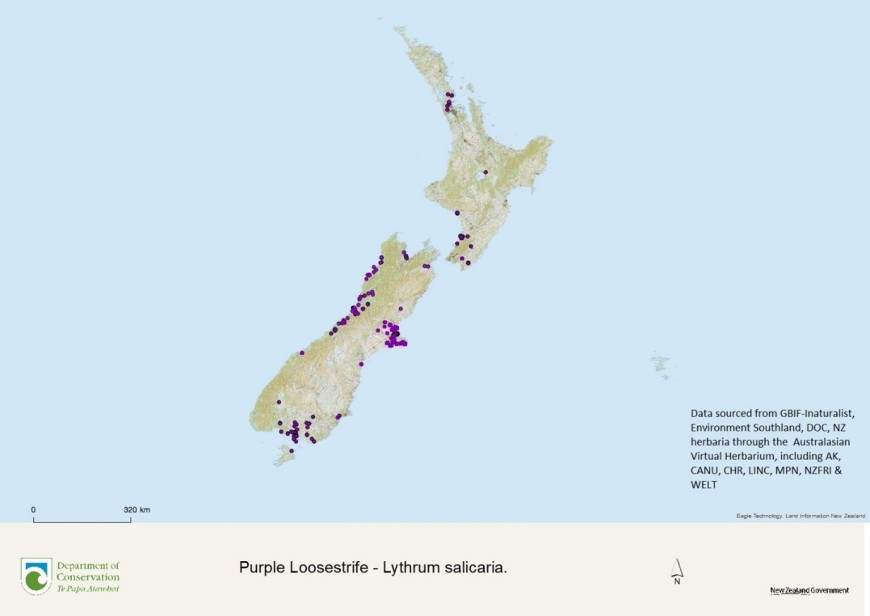Application to release purple loosestrife leaf beetles, root weevil and flower weevil

Image: Trevor James
The leaf-feeding beetles, Galerucella calmariensis and G. pusilla are small beetles that feed on the leaves of purple loosestrife. Both the larvae and adults can cause high levels of defoliation of dense stands of purple loosestrife preventing flower production.
The root weevil, Hylobius transversovittatus is a large weevil that feeds on the leaves and roots of purple loosestrife. The adults are nocturnal and feed on the leaves and stem tissue of the plant, but it is the larvae that attack the root system during their development that do the most damage.
The purple loosestrife flower (or seed) weevil is a tiny weevil that attacks the flower buds, young leaves and leaf buds of purple loosestrife. One egg is laid in a flower bud and the larva feeds on the stamens, petals and ovary of the flower, preventing the development of seeds. Without seeds, purple loosestrife cannot spread to new sites and increases in densities at existing sites will be slowed or prevented.
The application will seek approval to introduce these four insects into New Zealand to help control purple loosestrife.
Background
This application will be submitted by Horizons Regional Council, a member of the National Biocontrol Collective, a consortium of regional councils and the Department of Conservation. The Collective funds the development of weed biocontrol programmes in New Zealand. Manaaki Whenua - Landcare Research has assessed the feasibility of a biocontrol programme for purple loosestrife in New Zealand, and is preparing the application and managing the application process, including consultation with EPA and stakeholders. Horizons Regional Council is managing Maori consultation and engagement.
In its native range of Eurasia and Australia, purple loosestrife is considered to be an ornamental and medicinal plant but in its exotic range these benefits are heavily outweighed by its environmental impacts. In New Zealand, purple loosestrife invades wetland habitats, riparian and lakeside margins, roadside ditches, and even farmland, invading pastures and waterways and clogging drains. Once established, purple loosestrife populations can expand rapidly to form dense monocultures. In these situations, purple loosestrife can displace all other wetland plants, drastically altering native wetland and riparian ecosystems. The recreational and aesthetic value of lakes, steams, rivers and wetlands are drastically reduced by dense infestations of purple loosestrife. The tall plants block a view of the water and reduce native biodiversity, and access to water for recreational activities is made difficult.
High seed production, a vigorous and persistent root system and rapid growth rates contribute to the dominance and rapid spread of purple loosestrife in invaded ecosystems. Seeds are easily spread by water and wind, in footwear, and by water birds and other wildlife. Research on purple loosestrife invasion in the USA has shown the serious negative impacts of this weed on the structure, function and productivity of wetlands.
Biocontrol of purple loosestrife has not been considered in New Zealand until now. Biocontrol programmes for the same weed were initiated in the United States of America (USA) and Canada more than thirty years ago. The biocontrol agents proposed for release here are the same four agents that were released in the USA and Canada. These biocontrol programmes for purple loosestrife have been highly successful and we expect to have the same success in New Zealand resulting in reductions in the density and spread of the weed.
For more information about purple loosestrife and the biocontrol agents see:

Current distribution of purple loosestrife
Identification and assessment of risks, costs and benefits
The potential risks, costs and benefits associated with the proposed introduction of the two leaf beetles, and the root and flower weevils to New Zealand and the possible reduction in the abundance and vigour of purple loosestrife have been identified by literature review and by consultation with stakeholders.
The application will address in detail the potential significant adverse and the beneficial effects identified (highlighted in bold). The potential benefits of biological control will be the mitigation of the adverse effects of purple loosestrife on the New Zealand environment. The key potential adverse effects relate to impacts on native flora and fauna. These will be addressed fully in the application:
- direct damage to native plants
- direct damage to garden ornamentals
- indirect effects on flora and fauna as a result of disruption of ecological relationships
Purple loosestrife belongs to the family Lythraceae. There are no native species in this plant family. The closest native species are phylogenetically distant in the Willowherb family (Onagraceae) - three species of Fuschia and 38 species of Epilobium. The application will present evidence that no native species will be at risk from the leaf beetles and the weevils. Two exotic, ornamental species are related to purple loosestrife - crepe myrtle (Lagerstroemia inidica) and garden loosestrife (Lythrum virgatum) available as two cultivars, 'dropmore purple' and 'rose queen'. Tests and evidence from the USA indicate that these two species could be at risk of attack, and possibly other exotic naturalised species in the genus Lythrum (L. hyssopfolia, L. junceum and L. portula). The social and economic costs associated with possible attack on the exotic ornamentals will be canvassed and addressed in the application.. The results of that consultation will be presented in the application. Wild roses may also be at risk of some defoliation by the leaf beetles when populations are high. Any non-target attack by the beetles will be transient and of minor consequence since the larvae are not able to develop on any non-target species. Populations of the leaf beetle cannot be sustained on any plant species other than their host plant, purple loosestrife.
Because the leaf beetles and the weevils are highly host specific and rely on their host plant, purple loosestrife, for development of the immature stages to adults, population densities capable of interacting significantly with other plants or animals will only be found in close proximity to purple loosestrife. Mechanisms for interaction will be limited. As a result, no significant disturbance of ecological relationships is expected in New Zealand from the introduction of these four biocontrol agents.
Pre-application consultation with Iwi
The members of Te Herenga, the EPA's national network, will be contacted in January 2023 and invited to enter dialogue on plans to apply to the EPA to introduce another biocontrol agent for purple loosestrife.
The message to Te Herenga will describe how the applicant intends to assess the risks, costs and benefits associated with the proposed introduction. Members will be invited to identify any issues that they would like to be addressed in the application. Further consultation will be undertaken by Horizons Regional Council and Manaaki Whenua - Landcare Research.
At the request of the applicant, the EPA convened a reference group from Te Herenga to meet and discuss the issues surrounding the proposed applications. The application will address principles identified in that report.
Pre-application consultation with other organisations
Other organisations that will be consulted in the course of preparing this application include:
- Regional Councils
- Royal Forest and Bird Protection Society of New Zealand
- Department of Conservation
- QEII National Trust
- NZ Landcare Trust
- NZ Entomological Society
- NZ Plant Protection Society
- Apiculture New Zealand
Key documents
Reports on host-range determination
Safety issues are paramount in the minds of biocontrol of weeds researchers. Researchers rigorously test all proposed agents to assess the risk of damage to non-target plants. A set of procedures helps researchers choose a suitable shortlist of test plants, and this methodology is now well-accepted internationally. All four biocontrol agents proposed for release in New Zealand were thoroughly tested for host specificity prior to their release in the USA and Canada. We will use these tests results and field-based evidence of the agents' host range which will be fully presented and discussed in the application. The peer-reviewed publications presenting the results of host range testing and reports of non-target attack after release can be found here:
- pdf Host Specificity and Environmental Impact of the Weevil Hylobius transversovittatus, a Biological Control Agent of Purple Loosestrife (Lythrum salicaria) pdf File, 1.5 MB
- pdf Host Specificity and Environmental Impact of Two Leaf Beeltes (Galerucella calmariensis and G. Pusilla) for Biological Control of Purple Loosestrife (Lythrum salicaria) pdf File, 3.2 MB
- pdf Host Specificity of Three Potential Biological Weed Control Agents Attacking Flowers and Seeds of Lythrum salicaria (Purple Loosestrife) pdf File, 600 KB
- pdf Non-target feeding damage by leaf-beetles pdf File, 4.5 MB
- pdf Non-target Feeding of Leaf-Beetles Introduced to Control Purple Loosestrife (Lythrum salicaria L.) pdf File, 185 KB
- pdf Non-target Effects on Crepe Myrtle by Galerucella pusilla and G. calmariensis (Chrysomelidae), Used for Biological Control of Purple Loosestrife (Lythrum salicaria) pdf File, 1.6 MB
Cited references
Blossey B 2002. Purple loosestrife. In: Van Driesche R, Lyon S, Blossey B, Hoddle M, Reardon R eds. Biological Control of Invasive Plants in the eastern United States. USDA Forest Service Publication FHTET-2--2-04. Pp. 149-157.
Schonberger I, Wilton AD, Boardman KF, Breitwieser I, de Langa PJ, de Pauw B 2021. Checklist of the New Zealand Flora - Seed Plants. Lincoln, Manaaki Whenua - Landcare Research. http://dx.doi.org/10.26065/ax7t-8y85
www.nzpcn.org.nz/flora/species/lythrum-salicaria/
www.weedbusters.org.nz/what-are-weeds/weed-list/purple-loosestrife/
www.nzpcn.org.nz/flora/speices/lythrum-salicaria/
Key contact
